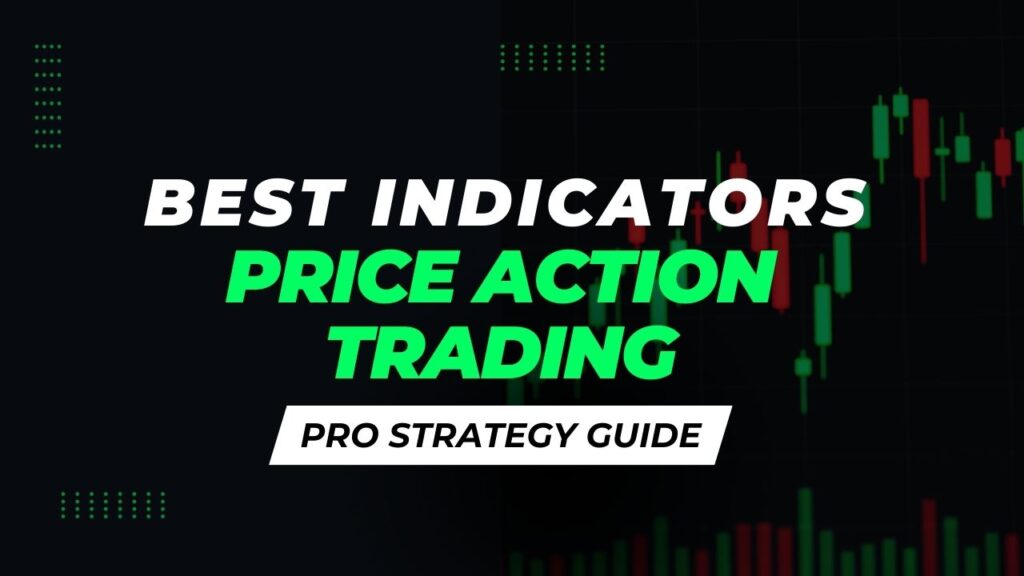
Best Indicators for Price Action Trading
Price action trading is about reading the raw language the market is talking—no messy charts or lagging signals required. In 2025, the arrival of algorithmic software and smart platforms like TradingView hasn’t altered this underlying fact: traders who master price action still have a serious advantage.
But here’s the twist—while old-school price action purists eschew indicators completely, the new pro utilizes a handful of intelligent indicators to augment price action decisions, not substitute for them. In this guide, we’ll unlock the top indicators for price action trading in 2025, how to properly utilize them, and which ones to avoid.
No matter if you’re a futures scalper, forex trader, or stock swing trader, this article combines penetrating insight with real-time trading experience, not speculation.
What Is Price Action Trading?
Price action trading is the method of learning how the price moves over time, usually without the use of lagging indicators. Price action trading emphasizes:
- Candlestick patterns
- Support and resistance
- Trendlines
- Breakouts and reversals
- Volume confirmation
It works amazingly well on charts such as TradingView, especially when paired with minimal but high-impact tools that complement clean price reading.
👉 Learn more about candlestick patterns and their role in scalping
Why Use Price Action Indicators
Best Indicators for Price Action Trading – You may wonder, “If price action is about clean charts, why would I use indicators?”
The goal isn’t to clutter the screen. It’s to confirm what the price is already indicating, minimize false signals, and get in at high-probability points. The trick is to select non-lagging, context-dependent indicators that:
- Verify momentum
- Measure volatility
- Remove noise
- Highlight key reaction zones
Let’s examine the top ones.
Top 7 Indicators for Price Action Trading (2025 Picks)
1. Volume Profile (Visible Range)
Purpose: Indicates volume traded at particular price levels, rather than by time.
Why It Works: Volume is king in price action. Volume Profile displays key support/resistance levels at which smart money is involved. It tells you where the price will stall, break, or reverse.
📌 Test it on TradingView: Look for “Fixed Range Volume Profile” among indicators.
2. Average True Range (ATR)
Purpose: It measures volatility, not direction.
Why It Works: ATR facilitates more intelligent stop-loss and take-profit targeting. Price action traders utilize it to gauge market rhythm, not just how far the price moves, but how far it may move next.
📌 Pro Tip: Take 14-period ATR and multiply by 1.5x or 2x to set a dynamic stop-loss.
3. Relative Strength Index (RSI)
Purpose: It gauges the velocity and change of price movement.
Why It Works: Price narrates the story, yet RSI tells us when that story is becoming overextended. Divergences between price and RSI (especially in higher timeframes) show reversals in advance.
✅ Apply RSI to confirm pullbacks, breakout strength, and concealed reversals.
👉 See our RSI divergence trading tips
4. Exponential Moving Averages (EMA 9/21 or 20/50)
Purpose: Price smoothing for micro-trend detection.
Why It Works: Intelligent price action traders utilize EMAs not for trading crossovers, but for:
- See trend bias
- Identify pullback zones
- Use as dynamic support/resistance
📌 Strategy: Look for rejections at EMAs in trend continuation setups.
5. Pivot Points (Daily/Weekly)
Purpose: Automatically calculates support and resistance levels from past candles.
Why It Works: Pivot points are battle-tested in price action trading, particularly in futures, forex, and indexes such as S&P 500 futures. Orders are clustered by traders at these levels, and they elicit a response in prices.
📌 Perfect for scalping and intraday setups on the 1-minute and 5-minute charts.
6. Volume Weighted Average Price (VWAP)
Purpose: The average price weighted by volume.
Why It Works: Institutions and smart money utilize VWAP as a fair value line. Price bounces off VWAP in trending markets. In ranging markets, it becomes a magnet.
📌 Day trading futures such as e-mini S&P 500, forex, and indices is a must.
7. Price Action Breakout Indicators (Premium or Customized Indicators
Purpose: Locate smart breakout points, trendlines, and liquidity areas.
Why It’s Great: TradingView now has premium features such as:
- LuxAlgo Smart Money Concepts
- Trendlines with Breaks [LuxAlgo]
- Price Action Concepts [TR]
They augment your price action strategy to arrive at faster and more precise decisions, particularly in intraday or scalping environments.
👉 Check our guide on TradingView indicators for scalping
Bonus: Top TradingView Configurations for Price Action
If you possess TradingView Free or Pro, the following setups are ideal:
- Timeframes: 1m, 5m, 15m for scalping; 1H, 4H for swing
- Chart type: Candlestick or Heikin Ashi
- Structure: Price + EMA + ATR + Volume Profile
Additionally, experiment with TradingView Desktop for smoother multi-chart monitoring.
Common Mistakes Price Action Traders Make with Indicators
Stay away from these if you wish to trade like a professional:
- ❌ Too many indicators simultaneously
- ❌ Disregarding the price context for signal lights
- ❌Relying on crossovers without checking the structure
- ❌ Failing to check volume on breakouts
📌 Restrict yourself to 2–3 indicators at most, and use them to validate, not dictate your trade idea.
Price Action Strategy Template (2025 Edition)
Here is a basic process to combine raw price action and indicators:
- Identify Trend using EMA or swing structure
- Identify Key Levels with Pivot Points or Volume Profile
- Wait for Candlestick Setup (e.g., Pin Bar, Engulfing)
- Confirm with Indicator (RSI Divergence, ATR volatility, VWAP hold)
- Enter Trade on retest or momentum confirmation
- Risk Management using ATR-based stops and position sizing
Is Price Action Still King in 2025?
Yes. It’s more relevant than ever, in fact.
With algorithms, fakeouts, and noise out there, those who can read the story behind the price have a lasting advantage. Some indicators provide clarity, not substitute skill.
Astute traders in 2025 blend conventional methods with smart tools for faster execution and reduced error.
Final Thoughts: Indicators That Empower, Not Distract
Price action is still the basis of professional trading. Indicators, if wisely selected, are your co-pilot, not your autopilot.
As you trade in 2025, dive deep into the tools that hone your edge while leaving the chart clean and intentional. Let price lead the way, and let indicators enhance your insight.



Pingback: Price Action vs Indicators: Which Wins in Day Trading? - Trading Views
Thanks for helping out, great info. “The laws of probability, so true in general, so fallacious in particular.” by Edward Gibbon.
Wow! Thank you! I permanently wanted to write on my website something like that. Can I include a part of your post to my website?